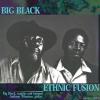BIG BLACK

ABOUT THE ARTIST/BIOGRAPHY
Master musician, percussionist and hand drummer, Big Black, was born Daniel Ray in Savannah, Georgia and grew up as a child in the Carolinas. Ray got his nickname from an older brother when he showed interest in drumming as a child. Unfortunately, “Big Black” has gotten far more notoriety for his colorful name than for his importance as an exceptional percussionist and one of the better practitioners of Afro-Cuban jazz rhythms in the 1960s.
After high school, Mr. Ray spent five years alternating between Florida and the Bahamas. During these formative (but inventive) years he played with Lord Flea's Calypso band in the Bahamas. Ray later formed a band with Jamaican trumpeter Billy Cook in Nassau and began mixing Caribbean and jazz rhythms. During the 1960s he often worked with jazz giants Randy Weston, Freddie Hubbard, Ray Bryant, Johnny Barracuda, Junior Cook, Eric Dolphy and Dizzy Gillespie. He subsequently was dubbed “The king of Congas”. A recording contract with UNI/MCA, led to the release of “Message to our Ancestors,” (’67) “Elements of Now,” (’68) “Lion Walk,” (’68) and “Big Black and the Blues” in 1972. These musical statements introduced collaborations with Dizzy Gillespie, Randy Weston, Hugh Masekela and Freddie Hubbard with Art Blakey on the recording, “Night of the Cookers.” The next two decades would prove to be truly eventful, on the theatrical level as well, as a musician in international films such as, Dizzy Gillespies’ Havana Bop, and When We Were Kings.
He has been in demand at international festivals such as: The Montreal, Monterey, Newport, The Playboy Jazz and Music Festivals, and at the Zaire Music Festival, prior to the Muhammad Ali Fight in 1974 (it was Big Black on congas in Ali’s corner that night to open the fight’s festivities).
Big Black continues to advance musically. His technique is considered unorthodox for a drummer, because he prefers to set out and approach the drums as a pianist would approach their instrument, left hand being bass or lower keys and the right hand, treble or the high keys. When Big Black is accompanying a pianist the tonal exchanges, reminds one of listening to mallets being played on the piano strings. His distinctive feel of melody and harmony, is what distinguishes Big Black from all other hand drummers and percussionist. In consideration of global influence of Big Black and his participation in the many variations and mutations of jazz and African drum influenced music over the past fifty years, he is being recognized for his musical contribution and achievements by being inducted into the Coastal Jazz Association of Savannah Hall of Fame for 2008. Back to Artists
LINKS
http://bigblackmusic.com/


